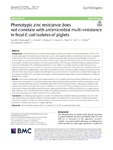Phenotypic zinc resistance does not correlate with antimicrobial multi‑resistance in fecal E. coli isolates of piglets
Ghazisaeedi, Fereshteh
Ciesinski, L.
Bednorz, C.
Johanns, V.
Pieper, L.
Tedin, K.
Wieler, Lothar H.
Günther, Sebastian
Background: Following the ban on antimicrobial usage for growth promotion in animal husbandry in the EU, nonantimicrobial
agents including heavy metal ions (e.g. zinc and copper), prebiotics or probiotics have been suggested
as alternatives. Zinc has extensively been used in pig farming, particularly during weaning of piglets to improve
animal health and growth rates. Recent studies, however, have suggested that high dietary zinc feeding during weaning
of piglets increases the proportion of multi-drug resistant E. coli in the gut, contraindicating the appropriateness
of zinc as an alternative. The underlying mechanisms of zinc effects on resistant bacteria remains unclear, but coselection
processes could be involved. In this study, we determined whether E. coli isolates from intestinal contents of
piglets that had been supplemented with high concentrations of zinc acquired a higher tolerance towards zinc, and
whether multi-drug resistant isolates tolerated higher zinc concentrations. In addition, we compared phenotypic zinc
and copper resistance of E. coli isolates for possible correlation between phenotypic resistance/tolerance to different
bivalent ionic metals.
Results: We screened phenotypic zinc/copper tolerance of 210 isolates (including antimicrobial resistant, multi-drug
resistant, and non-resistant E. coli) selected from two, independent zinc-feeding animal trials by determining a zinc/
copper minimal inhibitory concentration (Merlin, Bornheim-Hersel, Germany). In both trials, groups of piglets were
supplemented either with high dietary zinc (> 2000 ppm) or control (50–70 ppm, background) concentrations. Our
observations showed that high concentration zinc exposure did not have an effect on either zinc or copper phenotypic
tolerance of E. coli isolates from the animals. No significant association was found between antimicrobial resistance
and phenotypic zinc/copper tolerance of the same isolates.
Conclusion: Our findings argue against a co-selection mechanism of antimicrobial drug-resistance and zinc tolerance
after dietary zinc supplementation in weaning piglets. An explanation for an increase in multi-drug resistant
isolates from piglets with high zinc dietary feeding could be that resistant bacteria to antimicrobial agents are more
persistent to stresses such as zinc or copper exposure.
Files in this item

